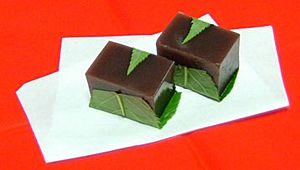Yōkan facts for kids

759 7456+
|
|
| Type | Wagashi |
|---|---|
| Place of origin | Japan |
| Main ingredients | Agar, sugar, red bean paste or white kidney bean paste |
Yōkan (羊羹) is a popular Japanese sweet. It is made from red bean paste, a jelly-like substance called agar, and sugar. Yōkan is usually sold in a block shape. People cut it into slices to eat.
There are two main kinds of yōkan. One is called neri yōkan. The other is mizu yōkan. The word "mizu" means "water" in Japanese. This type has more water in it. Mizu yōkan is often chilled. It is a refreshing snack to eat during the summer.
What Kinds of Yōkan Are There?
Most yōkan you find in Japan and other countries uses red bean paste. However, yōkan made from white kidney bean paste (しろあん, 白餡, shiro an) is also common. This kind of yōkan looks milky and clear. It has a much milder taste than the red bean paste version. Because of its light flavor, it is often mixed with other things. For example, it can be flavored and colored using green tea powder.
Yōkan can also have other yummy ingredients added. Some types include chopped chestnuts or persimmons. You might also find whole sweetened azuki beans or figs. There is even a kind called imo yōkan made with sweet potato. Instead of regular sugar, some yōkan uses honey, dark brown sugar, or molasses. These change the taste. There is also shio yōkan, which has a tiny bit of salt in it.
The History of Yōkan
Yōkan first came from China. It was originally a jelly made from boiling sheep. The name "yōkan" actually means "sheep geng". A "geng" was a thick soup.
This sweet was brought to Japan by Zen Buddhists. This happened during the Kamakura period and Muromachi period (around 1191). Buddhists do not eat meat. So, they changed the recipe. They replaced the animal gelatin with wheat flour and azuki beans. Later, around 1658, agar was discovered in Japan. This new ingredient was then used instead. This change led to the modern yōkan we know today.
Yōkan became one of the most popular Japanese sweets. It developed even more during the Edo period. This was when sugar became easier to get. Yōkan can be stored for a long time without needing a refrigerator, as long as it is not opened. Because of this, it is a very common gift item in Japan.
See also
 In Spanish: Yōkan para niños
In Spanish: Yōkan para niños


